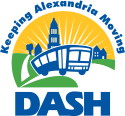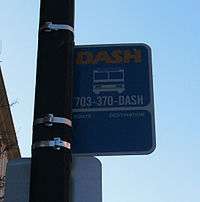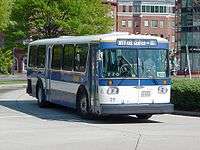DASH (bus)
Driving Alexandria Safely Home (DASH) is the public bus system for the city of Alexandria, Virginia, operated by the Alexandria Transit Company.
 | |
 A 2018 DASH Gillig Low Floor Advantage Diesel leaving King Street – Old Town station | |
| Slogan | Keeping Alexandria Moving |
|---|---|
| Parent | City of Alexandria |
| Founded | March 1984[1] |
| Headquarters | 3000 Business Center Drive, Alexandria, VA |
| Service area | Alexandria, Virginia |
| Service type | Bus service |
| Alliance | WMATA |
| Routes | 10 and the King Street Trolley[2] |
| Fleet | |
| Daily ridership | 13,900 (Q2 2016)[5] |
| Annual ridership | 4,209,500 (2015)[6] |
| Fuel type | Diesel, Diesel-electric Hybrid |
| Operator | Alexandria Transit Company |
| Website | dashbus.com |

The Alexandria Transit Company's DASH system provides safe, reliable, and courteous bus service within the City of Alexandria, and connects with Metrobus, Metrorail, Virginia Railway Express, and all local bus systems. DASH serves all of the Alexandria Metrorail Stations and the Pentagon Metrorail station during morning and evening peak periods.
Alexandria Transit Company (ATC) is a non-profit service corporation wholly owned by the City of Alexandria and currently operates 124 buses, including the King Street Trolley. ATC provides a fixed-route bus service within the City of Alexandria on nine routes and carries more than four million passengers annually. ATC operates transit services within portions of the City of Alexandria and between the City and the Pentagon Metrorail Station. ATC's purpose is to supplement the regional rail and bus service provided by the Washington Metropolitan Area Transit Authority (WMATA) and to provide a local bus service to the City of Alexandria.
History
In 1981, in anticipation of the opening of the Metrorail stations and the subsequent reordering of Metrobus service, the City Council authorized a feasibility study for a city-sponsored bus system. In 1982, the study recommended a five-route system, using 18 buses.
In 1983, the City Council developed an RFP (Request For Proposal) for management companies to develop a detailed plan for the operation of transit service in the City of Alexandria. The city chose to establish a non-profit public service cooperation that would be wholly owned by the City. This arrangement provided means by which:
- The transit system could be run as a business-type enterprise, and
- City Council could retain overall policy control yet be free from the day-to-day operation of a transit system.
On October 23, 1983 the City Council set up a Transitional Task Force and, on January 24, 1984, instructed the City Attorney to proceed with the incorporation of a non-profit company. The certificate of incorporation was issued by the State Corporation Commission on January 31, and the organizational meeting of the company was held February 6.
In January 1984, the General Manager employed by the Management Company that was awarded the management contract reported for duty and final preparations began for the opening of revenue service on March 11.
Ridership
DASH carries over 12,000 passengers per weekday[7] within the City of Alexandria, Virginia. The AT8 route, which runs through the Duke Street corridor, is DASH's busiest route with about 3,000 rides per weekday. In 2011, DASH ordered three new 40' Gillig Low Floor diesel-electric hybrid buses, which are 5' longer than the rest of the DASH fleet.[8] These buses went into service in April 2012. Five additional 40' Gillig Low Floor diesel-electric hybrid buses went into service in March 2013. The new 40' buses are used on the AT8 route to reduce crowding. On July 28, 2014, DASH introduced the new AT9 Crosstown Route.[9] The AT9 provides crosstown connections between Mark Center, Southern Towers, Northern Virginia Community College, Bradlee Shopping Center, Shirlington Transit Center in Arlington, Parkfairfax, Arlandria and Potomac Yard.
Fares
As of September 15, 2019, DASH's current base fare is $2.00 for riders paying cash or SmarTrip.[10][11] In 2007, DASH converted its buses to allow the use of the WMATA SmarTrip, an electronic debit farecard. DASH continued to accept and issue paper transfers until they were eliminated altogether January 1, 2013.[12]
Fleet
| Image | Builder | Model | Length | Year | Fleet Number | Fuel Propulsion | Powertrain (Engine/Transmission) | Notes |
|---|---|---|---|---|---|---|---|---|
 |
Orion Bus Industries | Orion V (05.503) | 35 ft (10.67 m) | 1999-2007 | 71, 74, 77, 78, 86, 87, 89-91, 95-97 (12 buses) |
Diesel |
|
|
| MCI | D4500 | 45 ft (13.72 m) | 2002 | 103-105 (3 buses) |
|
| ||
| Gillig | Phantom | 40 ft (12.19 m) | 1996-2007 | 101-102 (2 buses) |
|
| ||
 |
Neoplan USA | AN460 | 60 ft (18.29 m) | 2001-2002 | 601-614 (14 buses) |
|
| |
 |
Gillig | Low Floor | 35 ft (10.67 m) | 2011-2017 | 200-233 (34 buses) |
Diesel-electric Hybrid |
|
|

|
40 ft (12.19 m) | 300-311 (12 buses) |
|
|||||
 |
35 ft (10.67 m) | 2018 | 501-514 (14 buses) |
Diesel |
|
|||
 |
Low Floor Trolley^ | 29 ft (8.839 m) | 2011 | 400-404 (5 trolley buses) |
Diesel-electric Hybrid |
|
||
 |
35 ft (10.67 m) | 2015 | 405 (1 trolley bus) |
|
||||
 |
New Flyer Industries | XD35 | 35 ft (10.67 m) | 2019 | 515-527 (13 buses)[4] |
Diesel |
|
|
| 35 ft (10.67 m) | 2020 | 528-530 (3 buses)[4] |
|
| ||||
| XD40 | 40 ft (12.19 m) | 2020 | 701-705 (5 buses)[4] |
|
|
^operates under the King Street Trolley branding
Retired fleet
| Image | Builder | Manufacture Model | Order Year | Fleet Number | Powertrain (Engine/Transmission) | Year Retired | Notes |
|---|---|---|---|---|---|---|---|
| Orion Bus Industries | Orion I (01.502) | 1984 | 1-17 (17 Buses) |
|
|||
| Orion I (01.507) | 1986 | 18-19 (2 Buses) |
|
||||
 |
1990-1991 | 20-33 (14 Buses) |
|
2007 |
| ||
 |
Gillig | Phantom | 1996 | 34-43 (10 buses) |
|
2012 |
|
| 1998 | 44-53 (10 buses) |
|
2014 | ||||
| 1999 | 54-58 (5 buses) |
|
2015 | ||||
.jpg) |
Orion Bus Industries | Orion V (05.503) | 1999-2000 | 59–68 (10 buses) |
|
2017 |
|
 |
Gillig | Phantom | 2007 | 100-103 (4 buses) |
|
2019 |
|
Routes
| Route | Name | Terminals | Major streets | History | Notes | |
|---|---|---|---|---|---|---|
AT1 Plus |
Seminary Plaza – Beauregard – Landmark Plaza – Van Dorn Metro | Van Dorn Street station | Seminary Plaza | Duke Street, North Beauregard Street, Seminary Road | Originally ran as Route AT1[15] | Does not serve Mark Center on weekends.[16][17] |
AT2 |
Braddock Metro – Old Town – Mark Center – Lincolnia | Lincolnia | Braddock Road station | Seminary Road, King Street | This route operates via Old Town Alexandria | [18][19] |
AT2X |
Mark Center – King Street Metro Express | Mark Center Station | King Street – Old Town | Seminary Road, Duke Street | This route operates non stop between the two terminals. | Express route. weekday peak hour service only. |
AT3 |
Pentagon Metro – Parkfairfax – Old Town – Hunting Point | Hunting Point | Pentagon Station | West Glebe Road, Russel Road, West Braddock Road, Pendleton Street | weekday peak hour service only.[20][21] | |
AT4 |
Pentagon Metro – Parkfairfax – Old Town | City Hall via Old Town, Alexandria | Pentagon station | West Braddock Road, Madison Street, Montgomery Street | weekday peak hour service only.[22][23] | |
AT3/4 |
Old Town – Parkfairfax Loop | City Hall via Old Town Alexandria | Pendleton Street, West Braddock Road, Russel Street, West Glebe Road | This route operates on a loop around Parkfairfax | Off-peak hour and weekend service only.[24] | |
AT5 |
Braddock Metro – Old Town – Bradlee Shopping Center – Van Dorn Metro | Van Dorn Street station (Weekdays) & Eisenhower Avenue station (Weekends) | Braddock Road station | Van Dorn Street, King Street | This route operates via Old Town Alexandria | [25][26] |
AT6 |
Northern Virginia Community College (NVCC) Alexandria – King Street Metro | Northern Virginia Community College (NVCC) | King Street – Old Town | King Street | Route AT6 replaced Metrobus 28C in mid 2002. | weekdays only[27][28] |
AT7 |
Lee Center – King Street Metro – Van Dorn Metro – Landmark Mall | Landmark Mall | Nannie J. Lee Center | Eisenhower Avenue, King Street | This route operates via Eisenhower Avenue station | weekdays only[29][30] |
AT8 |
Braddock Metro – Old Town – Van Dorn Metro – Landmark Mall | Van Dorn Street station | Braddock Road station | Duke Street, King Street | This route operates via Old Town Alexandria | [31][32] |
AT9 |
Mark Center – Bradlee Shopping Center – Shirlington – Potomac Yard | Mark Center Station | Potomac Yard Shopping Center | Seminary Road, King Street, Glebe Road | This route serves Shirlington station in Arlington County. Sunday Service began on October 13, 2019.[15] | [33][34] |
AT10 |
King Street Metro – Del Ray – Potomac Yard | King Street – Old Town | Potomac Yard Shopping Center | Commonwealth Avenue, Mount Vernon Avenue | Route AT10 replaced Metrobus 9B and 10P on June 25, 2006.[35] | [36][37] |
KST |
King Street Trolley | King Street – Old Town | Potomac River Waterfront | King Street | This route is free[38] | |
References
- "Alexandria Transit Development Plan" (PDF). City of Alexandria Virginia. January 1, 2014. Retrieved 6 March 2019.
- "DASH Schedules & Maps". January 1, 2017. Retrieved 22 February 2019.
- "FY 2020 – FY 2025 Alexandria Transit Company (DASH) Transit Development Plan" (PDF). Alexandria Transit Company. March 14, 2019. Retrieved 18 July 2019.
- "Dash 35th Anniversary Celebration - Alexandria Living Magazine". Retrieved 4 March 2019.
- "Transit Ridership Report Second Quarter 2016" (pdf). American Public Transportation Association. August 22, 2016. Retrieved 14 November 2016 – via http://www.apta.com/resources/statistics/Pages/ridershipreport.aspx.
- "Transit Ridership Report Fourth Quarter 2015" (pdf). American Public Transportation Association. March 2, 2016. Retrieved 19 March 2016 – via http://www.apta.com/resources/statistics/Pages/ridershipreport.aspx.
- "Transit Ridership Report First Quarter 2016" (pdf). American Public Transportation Association. May 19, 2016. Retrieved 2016-09-17 – via http://www.apta.com/resources/statistics/Pages/ridershipreport.aspx.
- "DASH To Preview New Hybrid Low-Floor Bus And Trolley". Alexandria News. December 7, 2011. Retrieved 2016-09-17.
- "DASH Announces New AT9 Crosstown Route in Alexandria". Port City Wire. July 22, 2014. Retrieved 2019-03-06.
- "DASH Fares". Alexandria Transit Company. October 17, 2012. Retrieved 2016-07-17.
- "DASH 2019 Fare Change". Alexandria Transit Company. October 17, 2012. Retrieved 2016-07-17.
- "Important DASH Pass News!". Alexandria Transit Company. October 17, 2012. Archived from the original on August 7, 2016. Retrieved 2016-07-17.
- Malouff, Dan. "DASH is running the first non-WMATA articulated buses in Washington area transit". Greater Greater Washington. Retrieved 15 August 2019.
- "Metro Closure Overview DASH". Retrieved 25 May 2019.
- "Major Service Changes Effective October 13, 2019". October 1, 2019. Retrieved 13 October 2019.
- "DASH AT1 Plus Northbound" (PDF). October 1, 2019. Retrieved 13 October 2019.
- "DASH AT1 Plus Southbound" (PDF). October 1, 2019. Retrieved 13 October 2019.
- "DASH AT2 Eastbound" (PDF). October 1, 2019. Retrieved 13 October 2019.
- "DASH AT2 Westbound" (PDF). October 1, 2019. Retrieved 13 October 2019.
- "DASH AT3 Northbound" (PDF). February 3, 2019. Retrieved 6 March 2019.
- "DASH AT3 Southbound" (PDF). February 3, 2019. Retrieved 6 March 2019.
- "DASH AT4 Northbound" (PDF). February 3, 2019. Retrieved 6 March 2019.
- "DASH AT4 Southbound" (PDF). February 3, 2019. Retrieved 6 March 2019.
- "DASH AT3/4 Loop" (PDF). February 3, 2019. Retrieved 6 March 2019.
- "DASH AT5 Eastbound" (PDF). October 1, 2019. Retrieved 13 October 2019.
- "DASH AT5 Westbound" (PDF). October 1, 2019. Retrieved 13 October 2019.
- "DASH AT6 Eastbound" (PDF). February 3, 2019. Retrieved 6 March 2019.
- "DASH AT6 Westbound" (PDF). February 3, 2019. Retrieved 6 March 2019.
- "DASH AT7 Eastbound" (PDF). February 3, 2019. Retrieved 6 March 2019.
- "DASH AT7 Westbound" (PDF). February 3, 2019. Retrieved 6 March 2019.
- "DASH AT8 Eastbound" (PDF). February 3, 2019. Retrieved 6 March 2019.
- "DASH AT8 Westbound" (PDF). February 3, 2019. Retrieved 6 March 2019.
- "DASH AT9 Eastbound" (PDF). October 1, 2019. Retrieved 13 October 2019.
- "DASH AT9 Westbound" (PDF). October 1, 2019. Retrieved 13 October 2019.
- "Two Metrobus routes discontinued". June 23, 2006. Archived from the original on September 27, 2007. Retrieved May 11, 2020.
- "DASH AT10 Northbound" (PDF). February 3, 2019. Retrieved 6 March 2019.
- "DASH AT10 Southbound" (PDF). February 3, 2019. Retrieved 6 March 2019.
- "King Street Trolley Rackcard" (PDF). August 31, 2017. Retrieved 22 February 2019.
